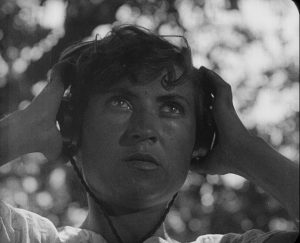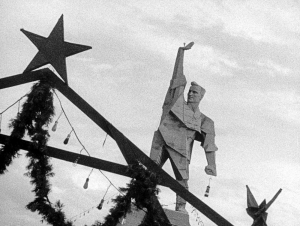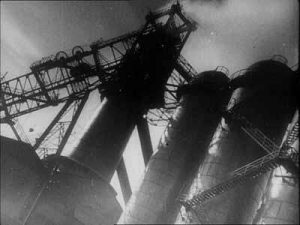
I went to see Enthusiasm or Symphony of the Donbass an experimental film by Dziga Vertov. I saw this screening at the Anthology Film Archive downtown, it was my first time attending a screening there and it was a great experience. The film begins with a young woman sitting outside at a table. She puts on headphones and then starts adjusting dials on a radio. It then cuts to shots of people praying in a village square. Vertov shows many different people kneeling and bowing their heads at the feet of a statue of Christ, after they finish their prayers they are shown kissing both of the icons feet. These clips are intercut with shots of Russian architecture, crosses, more statues of Christ, as well as alcoholics drinking and passed out in the square. I took this as a statement about loss of innocence. Following these shots are clips of groups of people parading through the streets and tearing down a church. They start to disassemble the church, taking out all of the religious paraphernalia and ripping down the crosses on the top of the steeples. The rest of the film shows different coal factories and factory workers doing endless amounts of labor, and then farm workers also working the fields. The reason this film is considered experimental is because it is the first film that Vertov created with sound. It is considered a symphony because the sounds of the rallies, workers, chants, and that of the coal factories and machine sounds create this almost rhythmic musical essence. What I noticed is that the sounds do not sync up with what is being displayed visually. This was somewhat jarring at first but then became hypnotizing. To me it seemed that the audio could be considered a character of the film on its own. This I believe was Vertov’s intention.

After reading a description of the intention of the film I realized that some of my assumptions were correct. Vertov intentionally did not sync the score of the film with the visual video aspect. What I found out was that the film was created to promote and celebrate Stalin’s Five Year Plan, and the Donbass region was a sort of epicenter of the plan. Due to the large amount of coal in the region it contained a lot of this natural resource. The Five Year Plan helped this region attain its full form of industrialization. During the film, there is an announcement made which states that the Five-Year Plan was completed in four years, which I did not catch while watching the film due to the fact that I do not speak Russian. This was possible because of the efforts of the workers, with their enthusiasm and dedication. Despite their completion of the Plan, they continue working, and the cycle never ends. Ending the film with showing the farm and field workers is a way of juxtaposing the old way of life to the new industrialized way of life that socialism formed. This specifically shows how the old way has been formally superseded by the industrialized and socialist world. In very thought out way, Vertov juxtaposed images of the role of religion and the field workers of the past with images of industry, production, and mechanization.
